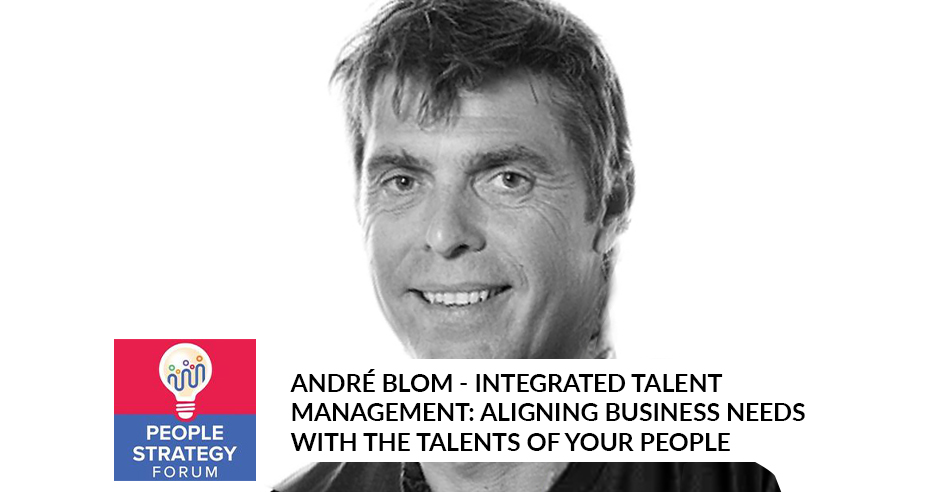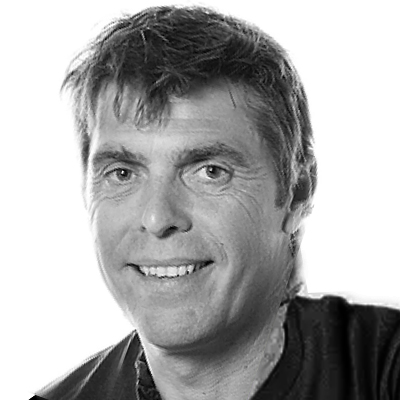André Blom – Integrated Talent Management: Aligning Business Needs With The Talents Of Your People

Do you feel like your talent is going unnoticed? Explore the transformative power of integrated talent management. Join this episode as we welcome André Blom, the co-founder of the TMA Method and the CEO of TMA International. Andre shares his journey from working in international staffing to reshaping talent management by aligning individual capabilities with business goals. Discover how fostering a culture of continuous improvement and employee engagement can unlock the untapped potential within your organization. This episode is packed with practical insights and strategies for leaders, executives, and talent managers aiming to harness the collective power of their workforce. Tune in for a compelling discussion on elevating your workplace and driving sustainable success.
—
André Blom – Integrated Talent Management: Aligning Business Needs With The Talents Of Your People
We’re a show that guides leaders to elevate the workplace overall and we believe that people are at the heart of successful organizations. A team member’s well-being, rewards, and career development are all exceptional to a happy, healthy, and highly productive workforce. This show discusses the practical and effective leadership strategies for executives, senior professionals, and talent managers overall.
Now, we have a couple of our hosts with us. We have Howard Nijswitz. Howard is a seasoned compensation and people strategist with a lot of experience in large organizations, and so forth. We also have Singla. Singla is broadcasting out of India. He has substantial experience in people strategies and he’s known as the Culture Guy. We’re pleased to have Sumit with us.
In this episode’s topic, we’re going to dive into Integrated Talent Management. It’s aligning business needs with the talents of your people. We are privileged to have André Blom with us. He’s a Divisionary Cofounder of the TMA Method. He has reshaped talent management by emphasizing the untapped potential within organizations and advocating for strategies that closely align individual capabilities with business goals overall.
With his extensive experience in organizational development, business consulting, people strategy, and social innovation, André has been a catalyst for creating environments where continuous improvement in employee engagement is not just encouraged but embedded into the culture. Join us as André shares his invaluable insights on harnessing the collective power of your workforce and the achievements overall. Welcome, André.
Thank you, Sam, for your nice introduction.
Let’s start with a little bit of a background, André, and how you got to where you are now. What created you to develop the TMA method and drive change in the market here?
The TMA Method
We have to go back around 25 years in my career. At that point, I was working for an international staffing company. We were doing projects where we worked with highly professional and skilled people in the IT sector, as well as engineers. What we discovered, or the feedback that we got from our clients, is that they’re always a little bit surprised by what the candidate could do.
They said, “But the candidate itself doesn’t give words to that. He is not framing or informing us what the real potential of this individual is, and we thought maybe we could help these individuals and also our business with the people that we would staff to present themselves in a better way. Instead of that, I talk about them, that he would do it himself.”
From that perspective, you start to explore what’s on the market. Are there any tools? Of course, immediately, you get into the field of assessments. What I explored or discovered, as you want to mention or name it, all the assessment tools were designed to talk about people. If you look at the reports and the outcome, most of the assessments are solid.
They are scientifically proven and well-researched. They are solid, but what we noticed is that the individual got a report and he was only interested in, “Am I in or am I out?” The wording that was used was not something that helped the candidate to give words to his contribution or to his person on it. I explored the market a little bit, and I found my two partners.
I said, “Can you design an assessment tool that is written for the individual so that the individual has more self-determination and gives words to himself when he’s going for a job?” The business started to run, they thought it was a good idea, and then we got into the market. Of course, we had to develop more than the individual assessment. We also thought about how we can help the candidate to create the right context for him or her to blossom.
Just imagine that you are a manager and you have 5 or 10 people or even 15 people on board. They’re all individuals. They all have their own needs. Can we expect from a manager that he understands how people click and tick? Should we say, as an individual, you’re also responsible for explaining the context, the circumstances, and the conditions where I can blossom and make an optimal contribution to the job that I’m executing?
From that point, we started to develop the whole talent management solution as we are now. In the beginning, of course, we also had the digital reports, but from a starting point, we always said that this was static. It’s nice to know how I click and tick. What are my conditions? That is also something that is, I think, related to talent management. It is also talent development.
From that point on, we thought that we had to make it more interactive. We have to have more adaptive content information that we can share with the clients and with the managers and how to connect them. This is where we are now. Where we have found a good fundament that people do not look in an instrumental way to each other, but in business in a fundamentally different way. Not as an asset but as an added value. That’s how we look at it.
What are the core ideas surrounding the TMA method? It sounds like it’s a lot about communication and ensuring that you’re having a healthy dialogue with your people.
The first core is as an individual, you have a certain obligation to understand yourself. In the world that we are living in, you hear a lot about others and how they think about you. Most of the time, it is a constraint for people. Think about how we think about our schooling systems. When you’re a bright young kid, you come in, you’re curious, you want to explore, and we funnel you down to a certain expertise. That is maybe nice and for some, it’s good, but for a lot of people, it is constraining.
As an individual, you have a certain obligation to understand yourself and in the world that we are living. Share on XWe did a lot of reviews and we asked people, “Are you happy on the job?” or “Do you feel that you’re contributing?” “Yes, we contribute.” “Are you contributing what you can or are you contributing on what you need to do?” That is staggering. A lot of people are saying, “I’m only doing what I have to do, not what I’m able to do.”
From that point on, one of our core elements of talent management is that you as an individual understand or learn to understand yourself in what you’re good at, what your preferences are, what you like to do, what you’re able to do, where your potential is lying, and what conditions you need to blossom and to grow.
One of our core elements is the me. How do I look at myself? Do I understand the talents? Do I understand what the difference between a talent and a skill is? I might be skilled to a certain extent but is that also where I’m talented at? Are there differentiations to find? Can I go in another direction? That is the first part, and we call it Personal Talent Management. You have to understand how you tick and click and what your conditions are to be successful.
Just to draw clarity between skills and talents, a person might have the knowledge to be able to do something, but the skill is to be able to apply it effectively. Is that correct?
Yes, what we say is you have a preference consciously or unconsciously in what you prefer to do, and that is derived from your personality. There’s something like your cognitive capability and then there’s a question like, is there an intrinsic motivation for you to do things or is it extrinsic? Do you have to do the things or do you want to do the things?
The nice thing is if you have to do things, but it’s coming from your intrinsic motivation. There, you have not only engagement but ownership, and then you add on your talents, values, and cognitive capabilities. You need knowledge and you need experience. That whole spectrum of these elements defines your skills.
When we talk about talents and skills, we say that there are a couple of layers that define your skills. We’re still looking at the individual, but the question is if you have the potential, the right drive, the right motivation, the right knowledge, and the right experience, does it mean that you’re an A performer? I would say, per definition, no, because the conditions and the context wherein you’re working are also very important.
We have seen this through life. It’s easy to say you’re an A employee in terms of sales by company Alpha, you switch over to company Beta, and all of a sudden, you’re not the high performer anymore. Why is that? Sometimes, I use the example of Messi. He was brilliant in Barcelona, but what a struggle in the Argentina team. Did he lose his skills, his motivation, or his talents? I don’t think so. The context and the conditions that he had to work with were different.
I think that it is important to know and to understand as a company that people are not a mechanism, not an instrument, and not a commodity, but they are a human resource, a unique resource that can adapt, to be creative, to be inventive, to collaborate, and to communicate. That is what we need in our business. It’s not that only a few happy senior leaders are the core of the success of a company. The whole configuration of people, the whole setup, and the whole collaboration of people is making a success.

Integrated Talent Management: It is really important to know and understand as a company that people are not just a mechanism, an instrument, and a commodity but they are a unique human resource that is able to adapt, be creative, be inventive, collaborate, and communicate.
I liked what you brought up a moment earlier about how you can find a person who is successful in one environment, but then when you bring them over to another environment, they may not be as successful. You need to understand a person’s unique talents in the environment that he thrives in. Understand that.
I fully agree, and another thing is that if I come into an organization as an MV, this is how I visualize it. I have my merits. I am who I am. I’m pretty aware of who I am and how I click and tick, but if I want to be successful in my job or the role that I get, there’s something that brings me there because if I have to, let’s say, drive in the way that I’ve always done it, then I’m not getting any further.
I go from A to B, but there’s no innovation. At the end of my journey, I will be obsolete. Why? Because I’m not learning anymore. I think the bridge between me as an individual and being successful in, let’s call it, a sustainable way, then the learning is important. This is also one of the objectives of leading people if you want to do that.
When do you allow them to lead and when do you allow them and help them to follow? It is because if you are leading and following, this is where you will learn. If you only follow, you will not learn if you are never allowed to lead. If I can lead on my experience and have an environment where there is a continuous dialogue,
For me, a dialogue is an exchange of perspectives and experience that we can both lift ourselves. This is what you do in a dialogue. I can be successful in the longer run from my perspective. I also think that if I blossom, part of my company will blossom, too. For me, talent management is knowing how you tick as an individual and what you need to learn so that you can be successful.
Leadership
That’s an important call out when we think about leaders nowadays. We need to think of it like reverse mentoring. We need to understand what our strengths are and how we can help people as leaders. Also, we need to think of our people and understand the unique skills and knowledge that they bring to the organization and how that might help us develop. Howard, in your experience working at large investment banking and so forth, do you often see a collaborative nature between leadership or managers and subordinates?
When I first entered the industry, I would say no. It was very much that managers controlled employees and directed employees, not caring much about what employees were thinking as long as things were getting done. The balance, of course, has changed over the years, but I think there’s still some reluctance in terms of embracing the full human being in the workplace.
Let’s face it: managers are under a lot of pressure to deliver, and sometimes they think that the straight line is getting from A to B. I think the human interface interaction is complex and it’s something that challenges them. Certainly, any tools that can be provided to facilitate that are great, but there also has to be some push for managers to say that, yes, this is part of their responsibilities.
I fully agree with you, Howard. It’s also about the mindset. The mindset has to be okay because we all probably have a little bit of experience. When you start as an NPE, you look up, you want to become a manager. Not everybody does, but some do, and this is the process. You first start your job by socializing. You want to be part of the group. You want to be included. You want to be seen.
If you want to be seen and you want to make a career, you’re not speaking out everything. You are politically correct because you want to have a position. The second phase comes, and maybe Sumit can say something about that, too. You feel like you have become an authority. You know how the business is done. You think that you are capable of understanding what is good and what is right for the company.
You get into some self-authorization, and then if people start to talk to you, you want to maintain the authority that you have given yourself. When there are issues, you tend to say, “I know how it works. Do it like this.” “I’ve seen this before. We have a new system. This will not work.” “I’m reluctant.” To help management get out of that, what I would call a Fixed Mindset, is the flip coin.
“I know everything best. Nothing can take me off my rock.” We need to help leaders get the mindset of what we call Self-Transformation, where they say, “I am an authority. I’ve proven that these are my merits, but to get further, I need to learn what I know from others and vice versa.” Learning together will bring the organization further.
Leadership is often confused with the hierarchy of the position. I would say that maybe you should have a hierarchy of talents or a hierarchy of dialogue or a hierarchy of who knows best, who is the best equipped, and who has the best talents to take the lead. Of course, I understand that for the legislation of an organization, you need a hierarchy.
Learning together will bring your organization further, and leadership is a lot of times confused with the hierarchy of the position. Share on XSomebody needs to be accountable for the total package, but I believe that everybody has a responsibility to take leadership or take ownership of what we’re doing together. Reach out to people, help, and collaborate. If you collaborate, you learn the most. If you are single, you don’t. That is also what I see in management.
Different layers. They don’t reach out to each other on the peer level, “Can you help me out?” It’s because it is saying something about, “I am not the authority. I need to know everything, and if I reach out to my peers, they might think that I’m not good enough.” I think a lot of things can change if we help leaders to have the right mindset.
If you talk to leaders about it, I think I don’t have the right number. We didn’t do any research about it, but in my own experience, if you talk to them in this way, 80% or 90% acknowledge this. I’m not reaching out to my fellow peer leaders to ask for questions. We’re not collaborating. I am not allowing my people to blossom in the right way because I have no time, I don’t have attention, I don’t have the tools or the instruments. That is what I hear from companies.
Talent-Based Organization
André, you’re talking about a skill-based or a talent-based organization. How can managers shift to a skill or talent-based type of organization? What are the first steps?
I don’t want to sound fluffy, Sam, but it is looking with human eyes at your human, fellow coworkers and starting a dialogue. Do you know where they are getting the energy from? Do you know why they are not engaged or maybe engaged but not taking ownership? Of course, you can say to start with the assessment tools and et cetera, but I think it starts with the dialogue.
It’s like in the family, when one of your kids is not doing well or between you and your spouse or partner, what do you do? Are you going for instruments or are you having a dialogue? One of the things that works in the way that human relationships work is, “I am good, you are good. Without any prejudice, we have to talk. What can we do together?” There, I would say that this is what I call the three F’s. Be Fair, be Friendly, and be Firm.
It’s okay as a leader to say, “This is what I expect from you.” but do that with kindness, with friendliness, and make sure that you have an open dialogue. If the candidate is not willing, not able, or doesn’t have the talents, you have to be firm and say, “Sorry, this is not your job. In my team, you cannot add any value. Can I look for another position for you?” Instead of letting people do things where it’s draining them, where they get sour, they’re sitting there, “I’m here for my paycheck.” That’s not what you want, right?
That would be my first step. Take the time and that was already a challenge for a lot of management, as Howard was saying. We’re running behind on our sales sheets and our reports. We’re all very busy. 80% of the job is about getting my things done and running to meetings. How much time do I spend with my people?
The Role Of HR
Do you think there has to be more focus on managers being held responsible for the development of their team members? Is that what’s missing?
With respect to the phenomenon of HR, if you look at history and from scientific management with McKinsey’s and Coveys, HR and management have never come together. If you see how HR is positioned in the organization, you could say that the priority for HR could be that you have to make sure that there is a workforce up to speed to deliver the business. That would be the first objective.
The second would be to make sure that your workforce is happy and their well-being. The third could be as HR, if you are a responsible company, to make sure that there’s societal welfare within the framework of what you’re able to do, maybe in a small community where your business is situated. Anyway, that could be the position. What we see now is that HR is fragmented.
We have a department for learning and development. We have a department for recruiting. We have a department for compensation and benefits. We have all kinds of good initiatives. As you can see, it’s not integrated. The connection between HR and line management and the workforce has no synergy. There is no understanding.
What we see is that, let’s say, human development, social cohesion, and professional cohesion in a team are leaning a lot on the shoulders of line management, where HR is trying to build strategies and offering systems. You can see the reluctance of line management to use it or to implement it. You see that a lot of businesses are leaning over, finding a new leverage, and bringing human talent management more on the shoulders and the hands and the responsibility of line management.
Just to give you a small example, maybe you know the company, Philips. They are also part of the medical industry. They have delivered the Apnea device and there’s a threat of a big claim from the United States because the device has caused some problems. They had to fire 6,000 people to take measurements so that they could afford to pay off the claim.
They started in EMEA in Europe with 22,000 and they had 80 HR people on board for 22,000 people and now they are going down to 40. How can 40 people work individually with 16,000 people? Impossible. Where do you go with your human resource management? If that’s the course. You also have to think about a scalable way.
Managers can make day-to-day interactions more labor intensive if they’re also pairing up people. Think about it and what it does to you. If you are responsible for your coworker and the other way around or partly responsible, let’s work together. If you have a little bit of a day off, I will support you so that your performance doesn’t go down.
I’m craving to develop this and you also. Why don’t we unite? Why don’t we help each other and provide feedback to our leaders? Why don’t we step up together? Let’s take this responsibility and share the innovative ideas that we have in the day-to-day operation. As a leader or a line manager, you can do much by activating your people. That is something HR has never been capable of doing.
The onus falls on the management team to take that responsibility. With HR, not owning it but facilitating that the line managers own the process, they own the development, and they go to HR as a resource where they need to find training programs and whatever else they need to support. HR is not owning it. I think that’s the problem in too many organizations.
Can I go a little bit more in-depth, Howard?
Sure.
The line management is not the only one who owns it. Think about a cell. A team is a cell of an individual with different skills. The team owns the performance, and they have to work together with a frontline manager, saying that we all have responsibilities and that I’m accountable for our team’s welfare and performance.
Fine enough, that is my position. I’m paid for that, but it doesn’t mean he is responsible for everything. Maybe he has somebody on his team who’s extremely good at de-escalating when it comes to social cohesion. Why don’t you ask that person instead of trying to get out of your comfort zone and do it? As frontline managers, if you show that I have a certain authority, so do my coworkers. Everybody has it. How can I make sure that we collaborate in the right way?
I’ve seen this working, and the results are amazing when you think about absence leave, sick rates, performance indicators, or productivity. When you feel that as an individual, “I belong here.” “I feel that I am valued.” “I feel that I can contribute from my energy, from my talents, and from who I am. I don’t have to be somebody else.”
Maybe we have to borrow more from sports teams because they have it together. This is how it works in sports teams. This is not rocket science. No. Henry Ford was amazing in his time. He managed to build a car in no time, where people were like mechanisms. One of the statements was, “I need muscles, but unfortunately, they take the brains with them.”
Nowadays, if you think about the available technology, we need so much to tap into the human skills in humanity. For example, I work a lot with AI to capture my thoughts, frame them in a model, and even produce text for my lectures or text for my e-learning content. If I rely on the AI, it comes out that sometimes it’s like hallucinating. It’s a little bit fluffy. It’s not me.
When I put my effort into it and I talk to others and this is how I think and how can we make it a better way, then AI is useful, but without my human touch, I consider it as worthless. We can think about technology as much as we want, but we need the human aspect of it. We need to humanize our business. Taylor’s scientific management structure is outdated. It will not bring us into the new era. Now I’m preaching, I’m sorry.

Integrated Talent Management: We can think about technology as much as we want, but we need the human aspect of it. We need to humanize our business.
I find that that’s a fascinating parallel, regardless of whether we’re talking to an artificial intelligence or human interaction is needed to ensure that we get the best result. To ensure that we’re having challenging ideas and a dialogue. That’s a good call out that you mentioned there, André. What’s similar between AI and humans is that we need to have that dialogue regardless.
We take that human nature and our intelligence and ensure we’re putting things in the right frame for better understanding. I would love to hear your point of view, Sumit, as we think about culture and the importance of dialogue overall. Do André’s statements make sense around the world in terms of what we’re looking at in India and so forth?
Let’s say, no. If you’re an HR person, what you’re saying makes it a true preference. I don’t think other departments evolved yet. We need to appreciate the newer analog talent management. Some leaders and founders still think of these things as intangible and then to see the light and be slightly more experienced. I don’t question the front, which is at what stage should an organization think about integrated talent management. This is something that’s the sense of at least part of thinking as models and I.
Integrated Talent Management
André, I think that maybe I could reframe this for Sumit. First of all, let’s define what does integrated talent manager or integral talent management means. One is the first part of the question, and the second part of the question is when a business and talent management team should think about bringing this together. Is there a certain size or phase that a business should be thinking about when they bring this together?
Let me start with the easy question, which is the last one. When do you start? What I see in Startups is that they are people-driven. They are not constrained by any form of process or rigid ISO certificates. They do things together. They are dialoguing. They are having standups. They’re doing it in a very agile way, and then they come to a point where they have come out of the incubation. They need to scale up and then the processes start. They need another layer of management.
When you’re a startup company, that is the point where you have to think about how you look at the value of the company. We came from all these bright ideas of people. How can we maintain that? That is a good starting point when you’re starting to think about scaling up because you will need different management layers. If you have a very flat organization, a small bakery, you know you have informal talent management because you work daily with each other. You have an understanding. It would almost be like a small family. I would ask you, Sam, if you conduct talent management in your family. I’m sure you are.
That’s right. It’s not such a mechanistic way, but of course, we’re constantly working with people who are of family or business.
For me, as soon as there is an extra management layer in an organization, you need talent because then you are not into day-to-day interaction with your people anymore. You have to figure it out. What are their thoughts? What is their innovative path? That is the easiest part. Every company that is reading this, did you install talent management?
I would say, excuse my French, and I’m allowed to do that because I’m Dutch. We are all French, we are straightforward forward, “Start right now, or otherwise it should be too late.” We are talking many times about the war on talent. If you don’t have talent management, how can you attract talent? Of course, there is a lot about talent management. Is it inclusive or is it exclusive? Is it the skill or is it the potential?

Integrated Talent Management: Start your integrated talent management right now, otherwise should be too late.
What I see as talent management is the two things that I said before, who am I? How do I tick and click? What do I need? I need to have an understanding and if people cannot give words to that, you have to help them because you need to understand that. Who do I mean with you? That is not only the manager but that is also your peer, the co-worker you’re sitting next to on the desk. He also has to understand how you work and vice versa.
This is a learning process. Do we understand each other? It’s coming from both sides. What can I learn from you and what can you learn from me? Talent management is for me to refrain from that; again, it is. How do I tick and click? How do you tick and click? Do we understand each other? As a team, we are connected. This is something that has to do with values. What values do we have in the organization? These are the cultural aspects.
If you look at a group of people, there’s always a micro-culture. Why is that? The most dominant talents are decisive in what culture we have. Think about it. If everybody has a preference to work on and I leave, then one person comes in with a mindset, “I am the boss.” What will happen? It will disrupt and influence the culture and create friction.
How can we help this person because he’s not a bad person? How can we help this person understand how others think he can adjust the way he’s positioning himself? Others can understand that he will sometimes do that. We can help him to understand that this is not our culture. There comes the dialogue again.
The connection between the individual and the others is about the cultural aspect and social cohesion, but for that, we need to understand each other. As I also said, it is about learning. If the individuals are learning and they’re learning with each other, they are successful. They bring it to a certain level. Think about it, Sam and the others. If we are learning, can we then do the same job again and again without adaption or without improving the way we work?
If I use the comparison to that, my daughter is now in the 10th grade and she is doing well. At the end of the year, she is assessed, a perfect job. What do we say as a result? You get a new saddle for your horse and you can do grade 10 again or are we allowing her to go to grade 11? What do we do with our employees? As compensation and benefit, are we rewarding the people or are we rewarding the seat?
What I would say is we have to allow people to grow from what they’ve learned. Otherwise, they stand still. This is a big issue in retention. Now comes another part. If you have the one, the I, the us, and the success, something is lacking here. That is the adaptability of the organization. What is your operating system?
We allow people to grow from what they've learned. Otherwise, they stand still. Share on XI don’t mean success factors or your financial program. I mean the way we work with each other, your processes, the agreements we have. If you don’t change that, then there is no innovation because then people are restricted. For me, the four elements, are I, success, we, and organization. The bridge between it and our talents. On the horizontal, it is the connection.
In the middle, it is individual learning and organizational learning. For me, this quadrant is capturing integral talent management. Where does HR come in? You already said it before. It is like facilitating, inspiring, listening, and having a dialogue. What can we do to make sure that line management has the tools, the skills, the knowledge, but also the liberty and the obligation to make sure that people are blossoming? Does that make sense?
Learn More
It is nicely said there, André. I know that there are a lot of our readers out there who are wondering, how do I learn more about the TMA method? How do I learn more about integral talent management? I know that TMA has a variety of resources. What would you recommend people as a start?
Of course, we have a lot of that. There’s something else to talent management that I didn’t mention, and that’s what would be called Competence Management. We talked about skills and what are human skills. An app that allows you to dive in and say that this is a competency model. This is not rocket science, but it is a model for organizations to say, “What do I expect from my people on a behavioral element?”
This is not about KPIs. This is not about whether you have closed six contracts or you’re capable of putting a hundred bolts into a whatever. It’s not about that. It’s about the human capacity. If you are clear in defining what you can do, building the model of the competencies, and aligning it with the talents, then you can see, “Does this person have the potential to deliver this behavior that will bring success?”
That will also help to have a fair compensation and benefits program because then you can say that we appreciate your talents and your human skills. Instead of, “You’re on this seat and if you are a top performer, you can get 5% in addition. If you’re an average performer, 2%, and if you’re under, you’re out.” That is not it. People are working together. We need to look differently to our workforce differently.

Integrated Talent Management: Your talents are your human’s skills.
Data-Driven Vs. Data Insight
André, we have a question from Jorge online. He is asking about the difference between data-driven versus data insight. Is that the words you use, sir?
Yes, I said data-driven or data-informed. If you look at what we are collecting now for data, it is about, of course, the KPIs that we have defined. It is about the sick rates or what I would call Cold Data, but we have to combine it with the warm data, what I call Human Data. Is that fair to say things like, “You did not reach your KPI.” for example?
Is that fair? That’s the call. If you do not understand the content, was he facilitated well enough? Did he have all the talents on board to accomplish the KPIs? Was there collaboration? In our world, we are interdependent on each other. If you are a line manager, do you have cold and warm data together so that you get into a comfortable bath where you can make a humanized decision about your stuff? You don’t want to be in the hot tub, and you’ll burn your feet. You don’t want a cold, although that might be good for your health once in a while.
You need a warm bath, and this is what I mean by making sure that your management is data-informed so that they can make human decisions. The data should be available for line management, not on the top, where analysts analyze the hard data and say, “Compared to the production level or compared to the sick rate.” It needs to be rooted. It needs to be grounded at the bottom of the organization. Does this resonate with you?
It does. Thank you very much, André. I appreciate you bringing this concept to our readers and talking about the importance of integral talent management and this desperate need for businesses of any size to think about putting this into place. Make sure that their people are well taken care of not only for the greater attraction of these important talents in their organization but also to retain their top performers and develop their people overall. Thank you for bringing this to us. I want to thank you, André, for joining us and sharing your wisdom.
You always offer your clients and your readers a first experience. They can go to the app store and find our free apps on competence management or career advice management. There are four apps, but I’m sure that you are willing to have a proper dialogue with your clients to help them out. Again, my message is to bring humanity back into business.
Thank you very much, André. If anybody would like to learn more about the TMA method, please reach out to us at [email protected]. They’re happy to take you through a demo. There’s also the TMA Method website out there, a simple Google search away and you can sign up for a demo through there. Thank you, André, once again for joining us on the show. We’ll see everyone next time.
Important Links
About André Blom

André Blom is the co-founder of the TMA Method and the CEO of TMA International. With over 30 years of experience in talent management and organizational development, André has a passion for leveraging human potential and fostering sustainable adaptability within businesses. His innovative approach to talent management focuses on integrating personal motivations and competencies with organizational goals, creating a harmonious and productive work environment. As a sought-after keynote speaker and consultant, André has helped numerous organizations worldwide enhance their leadership capabilities and drive business success through the TMA Method.




